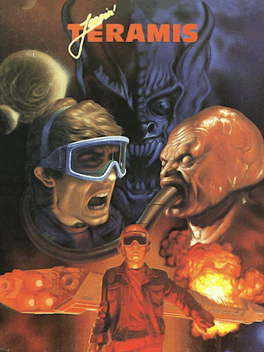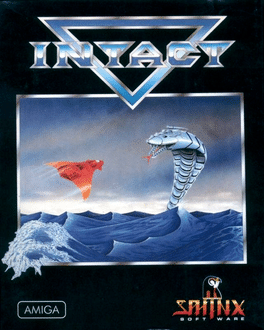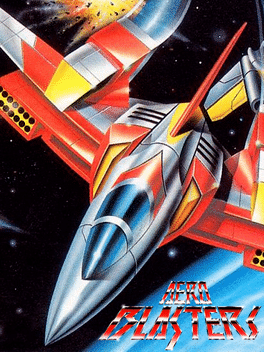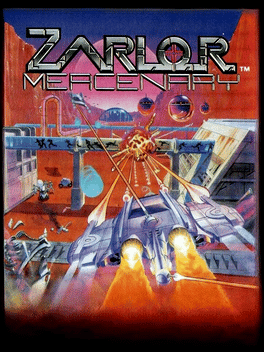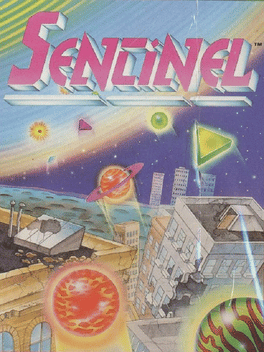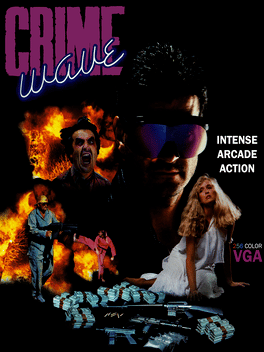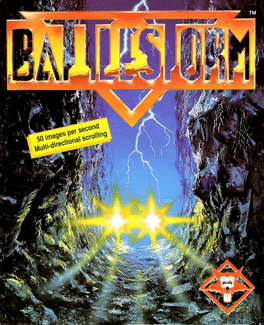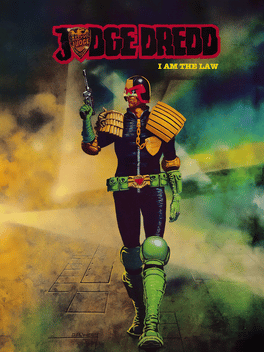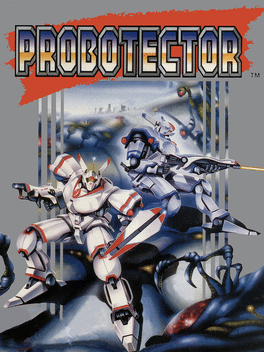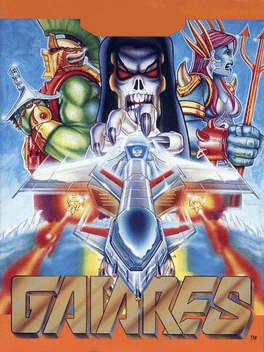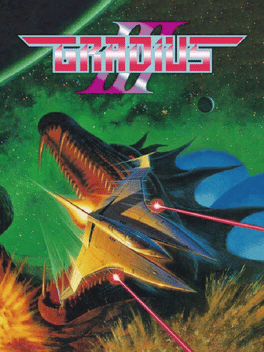New Wii Games - Page 426
-
Leavin' Teramis
1990
Leavin' Teramis
1990
A top down run and gun shooter for Atari ST and Amiga. The game consists of eight levels restricted by a time limit. -
Kamikaze
1990
Kamikaze
1990
Using buttons to move left, right and fire, you attempt to ward off invading aliens and their flying saucers. The aliens are dropped off from a saucer and stored in multiple columns until a column is full, then the aliens in that column descend, one by one, and attack. Also, the saucers sometimes descend to attack; if they are not destroyed, one ship is lost. -
Intact
1990
-
Aero Blasters
1990
Aero Blasters
1990
Aero Blasters: Trouble Specialty Raid Unit is a 1990 horizontally scrolling shoot 'em up video game developed and published by Kaneko and licensed to Namco. The game was originally released in the arcades in 1990 and was subsequently released for the PC Engine/TurboGrafx-16 (as Aero Blasters) and Sega Mega Drive/Genesis (as Air Buster in North America) in 1990 and 1991 respectively. In Aero Blasters, the player controls a fighter jet also designed for space travel and shoots enemies, collects power-ups, and defeats bosses to advance levels. As a console game, Aero Blasters had the distinction of being two player simultaneous, which was rare among side scrolling shooters on home consoles at the time; all games in the Thunder Force, Gradius, and R-Type series were only 1 player on the home consoles. -
Moon Blaster
1990
-
Zarlor Mercenary
1990
Zarlor Mercenary
1990
Zarlor Mercenary is a vertically scrolling shoot 'em up in which the player controls a spacecraft destroying enemy spaceships and buildings in order to earn money which can be used to buy upgrades between levels. At the end of each level there is a boss ship or landing craft that needs to be destroyed. Up to four players can play simultaneously using the Comlynx. Noted in the game manual you don't start with life but a fleet of ships. In single-player you start off with four ships, in two player mode you start off with three ships each. With three and four players you only start the game with two ships each. There are seven different pilot mercenaries to choose from, each having their own permanent unique weapon or skill. When playing in multiplayer mode, each player has a unique colour, you can either work together or towards completing the game. However one can purchase the weapon attachment backstabber that can kill another pilot causing him to loose money. The ship health bar is on the right as a horizontal gr -
Sentinel
1990
Sentinel
1990
Sentinel is a 1990 video game developed by Imagineering and published by Atari for the Atari 2600. It is the only light gun game ever released for the Atari 2600 platform. It was re-released with improved graphics for the Atari 7800 in 1991. -
Planet Smashers
1990
Planet Smashers
1990
Planet Smashers finally delivered an original 2D Shooter to the Pro System late in its life. Your spaceship, which oddly looks like an airplane, has the grave task of defending Earth from an alien armada. Planet Smashers has some nice features like level warp codes, laser upgrades, cloaking devices, and interesting bosses. You even have the burden of defending Earth's shield from asteroids and alien ships. The back of the box boasts, "awesome sound effects", but the main laser noise is mind-numbingly irritating. After you defeat the game, you are treated to a text ending commanding you to play Alien Brigade, which makes little sense since you just defeated the alien mothership. -
Crime Wave
1990
Crime Wave
1990
Crime Wave is a side-scrolling shooter with certain similarities to Narc in tone and gameplay. Controlling a police officer, the player shoots his or her way through slums, inner cities, and other locations, trying to destroy a powerful criminal organization and save the President's gorgeous, young, and single daughter. The game features digitized graphics. -
Battlestorm
1990
Battlestorm
1990
Message received on all emergency channels: "On behalf of the Empire of Worlds High Council, I bring you greetings! There is currently a state of emergency on all frontier worlds. The Kalomarian enemies led by their state of the art command vessels, the starships "Battlestorm", are taking over this galaxy. They are capable of destruction on a stellar scale. There is little time left to act and counter attack these invaders, but the Empire is already defenseless. ...nevertheless we hold hope, as the ancient prophecy has foretold..." "From the Ashes of conquest shall rise a warrior, and the storm will be blown away". Destroy squadrons to retrieve the vital "shield pods." Annihilate motherships to acquire "equipment pods". All these will protect you against the enemies' powerful attacks and provide you with more sophisticated weaponry. You will need all the help you can get if you are going to destroy the Battlestorms and launch your final attack on their headquarters. -
Alien Brigade
1990
Alien Brigade
1990
Alien Brigade is a side scrolling shooter similar to Operation Wolf. Aliens have arrived on earth and have brainwashed both soldiers and civilians in order to take over the world. Your job is to stop them! On each of the five levels you will have a different objective to complete, including saving civilians and destroying alien installations. Throughout the levels there will be numerous aliens and brainwashed people you will need to shoot, as well as attacking tanks, helicopters, and more. After shooting enemies a bonus may sometimes be left behind; if you shoot this, you can earn additional ammo, more powerful weapons, or increased health. If you don't shoot fast enough and are hit by enemy fire your health will slowly decrease; the game ends when all of your health is gone. -
Jumpjet
1990
Jumpjet
1990
Jumpjet was an action side-scroller in which the player piloted a jet to complete four missions, culminating in a "final" boss fight against the "Head of Doom". Defeating all four levels would bring the player loop the player back to the first mission. Play would continue as such until the player ran out of lives. -
The Terminator
1990
The Terminator
1990
DOS version based on the film of the same name. In the Year of Darkness, 2029, the rulers of this planet devised something that felt no pity. No pain. No fear. Something unstoppable. They created The Terminator. The cult movie phenomenon batters its way into your home in the most relentless arcade/adventure game of all time! From the nightmare world of the future to the mean streets of Los Angeles, The Terminator takes you right to the very edge...then pushes you over! Play urban commando Kyle Reese and pit your speed, skill and cunning against the most perfect killing machine ever devised. Or take a trip through the dark side and become The Terminator, a ruthless cyborg juggernaut bent on destroying mankind's last hope. It's your choice. One thing is certain...the fate of all humanity rides upon your next move. -
Judge Dredd
1990
-
Heavy Unit: Mega Drive Special
1990
Heavy Unit: Mega Drive Special (ヘビーユニット メガドライブスペシャル) is a 1990 Sega Mega Drive shoot-'em-up developed by Kaneko and published by Toho exclusively in Japan. It is a port of Kaneko's 1988 arcade shoot-'em-up Heavy Unit. Humans have developed an artificial planet, "Le Tau," which is being attacked by aliens, and only the Heavy Unit transforming ship can stop them. A and C shoot; rapidfire is an option. B drops a bomb, which you have an unlimited supply of but must collect as a powerup. Among the various powerups is one, labeled T, that transforms your ship into a mecha and back, which plays identically, except its bombs will home in on enemies. -
Probotector
1990
Probotector
1990
star 6.5Probotector is the European port of Contra (NES), which changes the main characters and enemies into robots. It was made based on the American version of the game, with the cutscenes changed accordingly. -
Gaiares
1990
Gaiares
1990
star 7.9Gaiares is a horizontal-scrolling shoot em' up released for the Sega Megadrive/Genesis in 1990. The game bears a striking mechanic similarity to that of the R-Type series, alongside those of other well-known Shoot Em' Ups such as Gradius and Thunder Force, all of which it was trying to compete against. -
Gradius III
1990
Gradius III
1990
In the darkest reaches of infinite space, pure evil lies in wait ... The Dark Forces led by the god of destruction, Bacterian, prepare to launch a massive onslaught against the planet Gradius. Possessing unstoppable power, the Dark Forces threaten to plunge the Universe into total war and complete annihilation. Their invasion force smashes the Gradius defenses, and the surrounding planets soon fall like dominoes. Now Bacterian's evil grasp reaches for the heart of the resistance...planet Gradius itself... To counter the oncoming threat the United Gradius World Forces gather all their fighter craft. Half of them form a defensive net - the other half a strike team. But they are badly outnumbered and The Dark Forces easily tear through their thin frontline. No fighters survive the slaughter.... In a last gasp move, the United Gradius World Forces send out two fighters, previously considered too dangerous for combat missions: The InterDimensional VIC VIPER fighters. The Fighters take off for the heart of darkness t -
Battle Unit Zeoth
1990
Battle Unit Zeoth
1990
star 6.3Battle Unit Zeoth takes place in the future where mankind is invaded by a race of alien robots known as the Grein. The Earth’s forces were triumphant in battle and the Grein forces fled the Solar System. However, as they retreated, the Grein left behind a secret underground base filled with self-replicating Grein machines. Forty-two years after the Earth’s victory, the Grein base opened and a new attack force decimated the city of New Age. To retaliate, Earth’s military has stored a mecha that specializes in alien combat known as the Zeoth. It is the Zeoth’s assignment to stop the attack force, go into the Grein secret base and destroy the mechanical occupants before a new invasion force arrives. -
M.U.S.H.A.
1990
M.U.S.H.A.
1990
star 7.8M.U.S.H.A. is a Sega Genesis vertical-scrolling shooter from Compile and Seismic originally released in 1990 and later re-released on the Nintendo Virtual Console in 2009. The game is known for its rarity and its ability to fetch high prices on auction sites.
